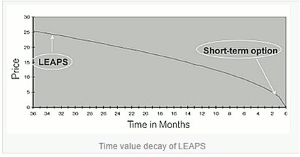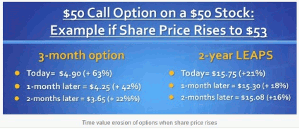As a follow-up to his previous article, Alan Ellman, of TheBlueCollarInvestor.com, goes into further detail regarding buying LEAPS (long-term options) as opposed to stocks, since understanding the mechanics of LEAPS is essential before implementing this product into an investment portfolio.
LEAPS are long-term options that have expiration dates between nine months and two and a half years out. The term is an acronym for Long-term Equity AnticiPation Securities. Once the expiration date is less than nine months away, LEAPS convert to conventional options. Some covered call writers will buy LEAPS in lieu of stocks and then sell call options on the same underlying security in what is known as a calendar spread. When both the strike prices and expiration dates of the long and short option positions are different, the strategy is known as a diagonal spread. When LEAPS are purchased, the mechanics of these securities are different from those of the shorter-term options we are more familiar with. This article will highlight these disparities.
Why Buy LEAPS?
LEAPS are cheaper than stocks so we are leveraging these securities to generate higher returns on our investments (ROI). If we buy a deep in-the-money LEAPS with a delta between 0.90 and 1.00, the option will behave much like its corresponding stock but at a much lower cost. Also, the time value erosion of LEAPS is much less than that of shorter-term options as seen in the screenshot below:
The time value erosion of LEAPS starts out slowly and linear. As it becomes a short-term option (approaches expiration) the pattern becomes logarithmic and falls off as cliff (right side of screenshot).
Disadvantages of LEAPS Related to Covered Call Writing
- Stock owners capture dividends, LEAPS holders do not
- Requires a higher level of trading approval than stock ownership when using covered call writing
- We are buying time and must overcome the time value paid for the option, slippage due to wide bid-ask spreads and time value erosion (theta) to make a profit or even break even
- Available on a limited number of stocks
- Bid-ask spreads are wide due to the nature of market-makers trying to price volatility so far into the future
LEAPS Slower Time Decay When Stock Price Remains the Same
If Share Price Rises Early, Short-term Options Benefit (same example as above)
Short-term options benefit more from a rise in share value than do LEAPS. However, as the short-term options reach expiration, they will be trading near parity ($3.00 of intrinsic value if the stock price is $53.00 for a $50.00 strike) while the LEAPS will still have significant time value component to it.
Discussion
Buying LEAPS is the same as buying time. The leverage involved can result in much higher percentage returns but we must overcome the time value cost to buy the security, wide bid-ask spreads as well as time value erosion to generate a profit. Understanding the mechanics of LEAPS is essential before implementing this product into our investment portfolios.
By Alan Ellman of TheBlueCollarInvestor.com













